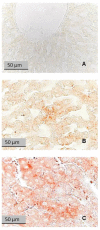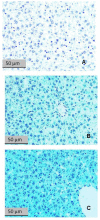Unveiling the Link: Exploring Mitochondrial Dysfunction as a Probable Mechanism of Hepatic Damage in Post-Traumatic Stress Syndrome
- PMID: 37629192
- PMCID: PMC10455150
- DOI: 10.3390/ijms241613012
Unveiling the Link: Exploring Mitochondrial Dysfunction as a Probable Mechanism of Hepatic Damage in Post-Traumatic Stress Syndrome
Abstract
PTSD is associated with disturbed hepatic morphology and metabolism. Neuronal mitochondrial dysfunction is considered a subcellular determinant of PTSD, but a link between hepatic mitochondrial dysfunction and hepatic damage in PTSD has not been demonstrated. Thus, the effects of experimental PTSD on the livers of high anxiety (HA) and low anxiety (LA) rats were compared, and mitochondrial determinants underlying the difference in their hepatic damage were investigated. Rats were exposed to predator stress for 10 days. Then, 14 days post-stress, the rats were evaluated with an elevated plus maze and assigned to HA and LA groups according to their anxiety index. Experimental PTSD caused dystrophic changes in hepatocytes of HA rats and hepatocellular damage evident by increased plasma ALT and AST activities. Mitochondrial dysfunction was evident as a predominance of small-size mitochondria in HA rats, which was positively correlated with anxiety index, activities of plasma transaminases, hepatic lipids, and negatively correlated with hepatic glycogen. In contrast, LA rats had a predominance of medium-sized mitochondria. Thus, we show links between mitochondrial dysfunction, hepatic damage, and heightened anxiety in PTSD rats. These results will provide a foundation for future research on the role of hepatic dysfunction in PTSD pathogenesis.
Keywords: anxiety; cytokines; hepatocytes; inflammation; liver; mitochondria; oxidative stress; phenotypes; post-traumatic stress disorder; rats.
Conflict of interest statement
The authors declare no conflict of interest. The funding agencies had no role in the design of the study; in the collection, analyses, or interpretation of data; in the writing of the manuscript, or in the decision to publish the manuscript.
Figures














Similar articles
-
Cardiac injury in rats with experimental posttraumatic stress disorder and mechanisms of its limitation in experimental posttraumatic stress disorder-resistant rats.J Appl Physiol (1985). 2021 Mar 1;130(3):759-771. doi: 10.1152/japplphysiol.00694.2019. Epub 2021 Jan 7. J Appl Physiol (1985). 2021. PMID: 33411642
-
High intensity interval training protects from Post Traumatic Stress Disorder induced cognitive impairment.Behav Brain Res. 2021 Jan 15;397:112923. doi: 10.1016/j.bbr.2020.112923. Epub 2020 Sep 22. Behav Brain Res. 2021. PMID: 32976860
-
Intermittent Hypoxic Conditioning Alleviates Post-Traumatic Stress Disorder-Induced Damage and Dysfunction of Rat Visceral Organs and Brain.Int J Mol Sci. 2020 Jan 5;21(1):345. doi: 10.3390/ijms21010345. Int J Mol Sci. 2020. PMID: 31948051 Free PMC article.
-
The role of suboptimal mitochondrial function in vulnerability to post-traumatic stress disorder.J Inherit Metab Dis. 2018 Jul;41(4):585-596. doi: 10.1007/s10545-018-0168-1. Epub 2018 Mar 28. J Inherit Metab Dis. 2018. PMID: 29594645 Review.
-
Mitochondrial dysfunction in animal models of PTSD: Relationships between behavioral models, neural regions, and cellular maladaptation.Front Physiol. 2023 Feb 15;14:1105839. doi: 10.3389/fphys.2023.1105839. eCollection 2023. Front Physiol. 2023. PMID: 36923289 Free PMC article. Review.
Cited by
-
Characteristics of Psychoemotional Manifestations of Laboratory Rodents Undergoing Surgery when Modeling Preoperative Stress.Bull Exp Biol Med. 2024 Sep;177(5):678-681. doi: 10.1007/s10517-024-06248-z. Epub 2024 Oct 1. Bull Exp Biol Med. 2024. PMID: 39352674
-
Exploring comorbidity networks in mild traumatic brain injury subjects through graph theory: a traumatic brain injury model systems study.BMC Neurol. 2025 Mar 7;25(1):94. doi: 10.1186/s12883-025-04102-x. BMC Neurol. 2025. PMID: 40055666 Free PMC article.
References
-
- Smagin D., Kovalenko I., Galyamina A., Belozertseva I., Tamkovich N., Baranov K.O., Kudryavtseva N. Chronic lithium treatment affects anxious behaviors and the expression of serotonergic genes in midbrain raphe nuclei of defeated male mice. Biomedicines. 2021;22:1293. doi: 10.3390/biomedicines9101293. - DOI - PMC - PubMed
MeSH terms
LinkOut - more resources
Full Text Sources
Medical

